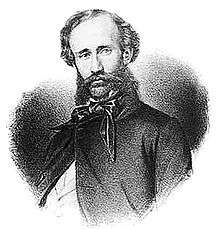Carl d'Unker
| Carl d'Unker | |
|---|---|
 | |
| Born |
Carl Henrik d'Unker Luetzow 9 February 1828 Stockholm, Sweden |
| Died |
24 March 1866 (aged 38) Düsseldorf, Germany |
| Nationality |
|
| Known for | Painter |
| Movement | Düsseldorf school of painting |
Carl Henning Lutzow d'Unker (9 February 1828 – 24 March 1866)[1] was a Swedish artist. He was mostly known as a socially oriented genre painter whose works depicted contemporary subjects, such as waiting rooms at railway stations or scenes from pawnshops.[2]
Biography
D'Unker's father was a Norwegian soldier, while his mother was Swedish. He began his career as a soldier and served in the Svea Life Guards for a short time. In 1848 he volunteered for the First Schleswig War (1848-1849).[3] Shortly after his return to Sweden he abandoned his military career in favor of an artistic one. He moved to Düsseldorf to study painting, where he married Clara Schnitzler, the daughter of master builder Peter Heinrich Gregor Anton Schnitzler, on 25 June 1859, after which he was able to live a carefree life financially.[4] He became a very popular artist on the continent. From 1861 he suffered from sickness in his right arm and was forced to paint with his left arm. In 1864 he and his wife had a son, Detlev Wilhelm Albert d'Unker Luetzow. He made a brief visit to Sweden in 1865, and was appointed professor by the Swedish king Charles XV. He died the following year.[3]
Gallery
 Woman with a Rosary. (1853)
Woman with a Rosary. (1853) Second-class waiting room. (ca 1865)
Second-class waiting room. (ca 1865) Third-class waiting room II. (1865)
Third-class waiting room II. (1865) Gypsy Family in Prison (1864)
Gypsy Family in Prison (1864) The Pawnshop II (1859)
The Pawnshop II (1859)Free.jpg) The Pawnshop (V). (1860)
The Pawnshop (V). (1860)
References
- ↑ Carl d'Unker in Nationalencyklopedien (in Swedish)
- ↑ "Carl Henrik D'Unker, Real Paintings, Real Testimonials".
- 1 2 Carl D'Unker in Nordisk familjebok (in Swedish)
- ↑ Svenska Konstnärer, Biografisk Uppslagsbok 2000. Svenska Konstnärer Galleri och Bokförlag AB. 1999. p. 109. ISBN 91-973689-0-3.
See also
| Wikimedia Commons has media related to Carl D'Unker. |